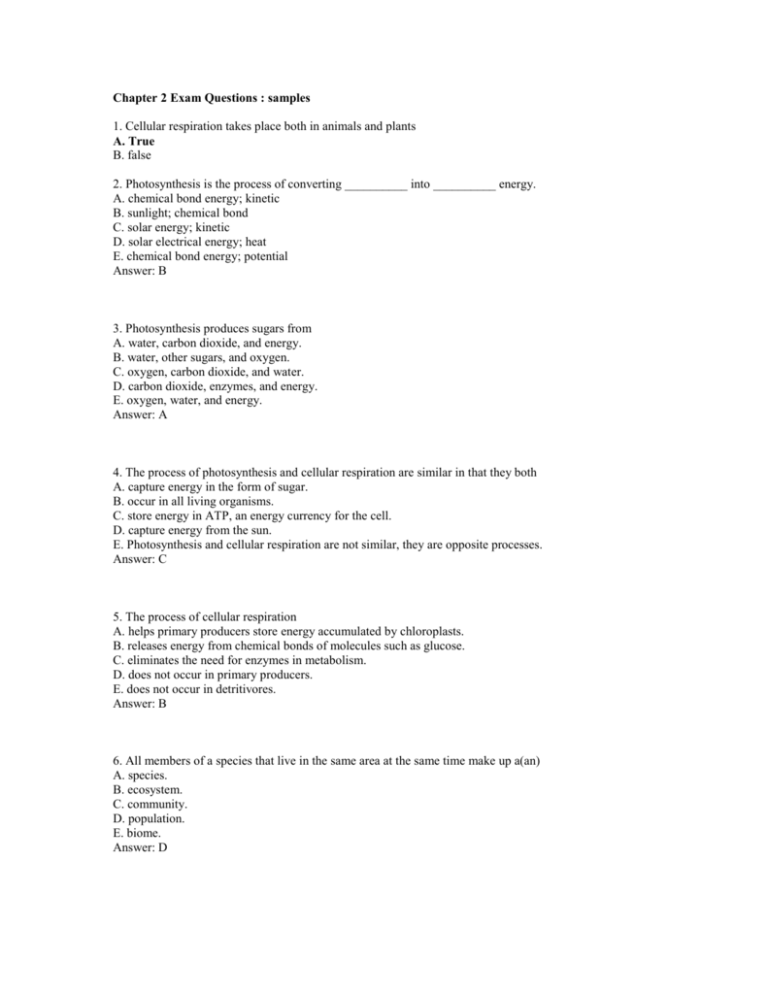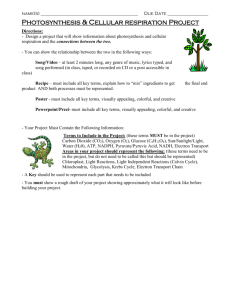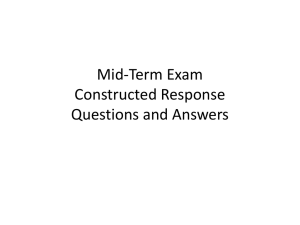Exam 2: Samples - Faculty Web Pages
advertisement

Chapter 2 Exam Questions : samples 1. Cellular respiration takes place both in animals and plants A. True B. false 2. Photosynthesis is the process of converting __________ into __________ energy. A. chemical bond energy; kinetic B. sunlight; chemical bond C. solar energy; kinetic D. solar electrical energy; heat E. chemical bond energy; potential Answer: B 3. Photosynthesis produces sugars from A. water, carbon dioxide, and energy. B. water, other sugars, and oxygen. C. oxygen, carbon dioxide, and water. D. carbon dioxide, enzymes, and energy. E. oxygen, water, and energy. Answer: A 4. The process of photosynthesis and cellular respiration are similar in that they both A. capture energy in the form of sugar. B. occur in all living organisms. C. store energy in ATP, an energy currency for the cell. D. capture energy from the sun. E. Photosynthesis and cellular respiration are not similar, they are opposite processes. Answer: C 5. The process of cellular respiration A. helps primary producers store energy accumulated by chloroplasts. B. releases energy from chemical bonds of molecules such as glucose. C. eliminates the need for enzymes in metabolism. D. does not occur in primary producers. E. does not occur in detritivores. Answer: B 6. All members of a species that live in the same area at the same time make up a(an) A. species. B. ecosystem. C. community. D. population. E. biome. Answer: D 7. A biological community consists of all A. populations living and interacting in an area. B. members of a species living in the same area. C. living things on Earth. D. populations of a given species. E. members of a species living in the same biome. Answer: A 8. An ecosystem consists of A. a physical environment within which a biological community lives. B. the species with which a biological community interacts. C. a biological community and its physical environment. D. the primary producers within a biological community. E. all the species in a biological community. Answer: C 9. The length and complexity of a food web in the Arctic would be ____________ when compared to one in the tropical rainforest. A. short and less complex B. short and more complex C. long and less complex D. long and more complex E. about the same Answer: A 10. Producers rely on ____________ to release chemical energy and consumers rely on ____________ to release chemical energy. A. cellular respiration; photosynthesis B. cellular respiration; cellular respiration C. photosynthesis; cellular respiration D. photosynthesis; photosynthesis E. the sun; the sun Answer: B 11. Primary consumers are also known as A. carnivores. B. scavengers. C. decomposers. D. herbivores. E. top carnivores Answer: D 12. Energy enters a system as sunlight and a producer is able to produce 10 kilograms of tissue. If eaten, the producer would produce about ______ kilograms of consumer tissue that would provide about __________ kilograms of tissue for a secondary consumer. A. 100; 10 B. 10; 1 C. 100; 1 D. 1; 0.1 E. 10; 0.1 Answer: D 13. Living vegetation and the ocean are known as “carbon sinks” because A. they are made of carbon. B. they create carbon. C. they destroy carbon. D. they store carbon. E. due to gravity carbon is found closer to the ground. Answer: D 14. Nitrogen is an essential component of amino acids and proteins. A. True B. False Answer: A 15. Photosynthesis is a step in the global nitrogen cycle. A. True B. False Answer: B Chapter 3 Populations, Communities, and Species Interaction 1. There is/are usually _______ tolerance limit(s) responsible for limiting the number and location of a species. However, some organisms have ____________ that limit(s) their distribution. A. one; a specific critical factor B. one; other environmental conditions C. one specific; many factors D. many; other environmental conditions E. many; a specific critical factor Answer: E Use the following example for the next two questions. A species can withstand a narrow range of temperature. Above 100°F there are no species present. In the range from 97°F–100°F and 90°F–94°F there are a few species present. Below 90°F there are no species present. 2. What would you label the range of temperature from 90°F to 94°F for this particular species? A. zone of intolerance B. zone of physiological stress C. tolerance limit range D. optimal range E. range of tolerance Answer: B 3. What would you label the range of temperature from 95°F to 96°F for this particular species? A. zone of intolerance C. tolerance limit range B. zone of physiological stress D. optimal range E. range of tolerance Answer: D 4. What is the difference in the adaptation of a sled dog’s (such as a Husky) thick coat of hair to help it withstand the cold temperatures of Arctic winters and a dog that adapts to cold temperatures in the fall by growing a thickened coat? The adaptation of the sled dog best describes adaptation at the ____________ level while the dog exposed to seasonal colder temperatures has _____________. A. regional; natural selection at the individual level B. individual; physiological modifications at the population level C. population; physiological modifications at the individual level D. species; natural selection at the population level E. ecosystem; physiological modifications at the individual level Answer: C 5. Evolution occurs as a result of A. the discovery of a desirable characteristic in a population. B. an individual’s physiological modification. C. environmental change that forces modification in a resident species. D. better survival or reproduction rates by individuals with a particular characteristic. E. a population’s physiological modification. Answer: D 6. Natural selection will ultimately makes a species A. more intelligent. B. physically bigger. C. more adapted to its environment. D. more aggressive. E. less vulnerable to its predators. Answer: C 7. Regular lawn mowing selects for short-headed rather than tall-headed dandelions because A. tall flowers spread their seeds farther. B. tall flowers cannot reproduce. C. short flowers can reproduce. D. short flowers spread their seeds farther. E. short flowers have less competition when the lawn is mowed often. Answer: B 8. A Titmouse and a Chickadee are living in the same territory and are using some of the same resources. The best way to classify this interaction is as A. mutualism. B. intraspecific competition. C. interspecific competition. D. symbiosis. E. commensalism. Answer: C 9. Which of the following is not a common strategy for successful interspecific competition? A. Eating prey before they are “ready” (ripe) for other species. B. Spreading seeds or offspring far and fast. C. Producing substances that are toxic to competitors. D. The life cycle of dragonflies (the larva live in the water). E. All of these are strategies for successful interspecific competition. Answer: D 10. An especially effective strategy for reducing intraspecific competition is A. different ecological niches for juveniles and adults. B. rapid reproduction. C. eating prey before they are “ready” (ripe) for other species. D. resource partitioning. E. None of these. These are examples for reducing interspecific competition. Answer: A 11. Symbiosis means A. a relationship in which both species benefit. B. a parasitic relationship. C. commensalism. D. living together. E. a relationship in which one species benefits and the other does not benefit. Answer: D 12. In the partnership of a lichen, the fungus provides _________ and the relationship is best described as _______. A. most of the photosynthesis; symbiosis B. poisons that deter predation; commensalism C. structure and moisture-holding ability; mutualism D. very little to the algal partner; parasitism E. some of the photosynthesis; commensalism Answer: C 13. An organism’s biotic potential is the maximum number of offspring A. that it can produce. B. that survive to adulthood. C. its habitat can support. D. it produces at one time. E. it actually produces over its lifetime. Answer: A 14. A dieback, or population crash, often occurs after a species ________ its environmental carrying capacity. A. meets B. overshoots C. undershoots D. oscillates around E. decreases Answer: B 15. In the real world, many factors determine the numbers of organisms in any one population. Yet, a SUPERFLY with unlimited food and no mortality would show what type of growth? A. carrying capacity geometric increase B. irruptive growth C. J-shaped curve D. S-shaped curve E. Malthusian growth Answer: C 16. A biological community’s productivity is a measure of A. its number of species. B. the number of individuals in the community. C. available solar energy that can be converted to biomass. D. the amount of biomass produced in the community. E. All of these are combined in measuring a community’s productivity. Answer: D 17. In a biological community where diversity is great, such as a tropical rainforest, the abundance of any one species is likely to be A. great. B. small. C. widely variable from year to year. D. the same from year to year. E. None of these. Abundance does not depend on diversity. Answer: B 18. Complexity in an ecological community has to do with the number of A. species in the population. B. species at each trophic level. C. genetic variations within a species. D. primary producers available. E. primary producers relative to the number of consumers. Answer: B 19. A community with hundreds of different types of primary producers, a few herbivores, and only one carnivore, has A. little complexity. B. little diversity. C. a great deal of complexity. D. low productivity. E. a great deal of productivity. Answer: A 20. Primary succession occurs when a community develops ____________ while secondary succession occurs when one ________. A. into a climax community, species replaces another B. and replaces another, ecosystem becomes stable C. on unoccupied ground, biological community replaces another D. and then fails, niche changes E. intraspecific competition, experiences interspecific competition Answer: C 21. Which of the following are pioneer species? A. wood warblers B. dandelions C. starlings D. lichens E. humans Answer: D 22. As ecological development proceeds, a biological community A. gradually stagnates. B. becomes more diverse. C. goes through repeated secondary succession stages. D. goes through repeated primary succession stages. E. becomes less complex. Answer: B 23. A climax community is one that A. is relatively stable and long lasting. B. lasts forever. C. contains oaks or White Spruce. D. is impervious to disruption. E. is adapted to periodic disruption. Answer: A 24. The most common reason that introduced species cause trouble is because they are larger than native species. A. True B. False Answer: B 25. The introduction of a predator onto an island originally free from predators is likely to cause the extinction of a native species. A. True B. False Answer: A Chapter 15 1.National Environmental Policy Act (1970) was signed by President Nixon A. True B False 2.---------is one of the most powerful tool in the environment arsenal A.Enviromment Impact Statement B. Environment regulations C. Endangered species Act D. EPA 3.Environmental laws are laws that A. govern environmental quality, natural resources & ecological sustainability B. protect our soil C. govern all legislative laws D. one need not obey 4.Criminal Law – Derives from federal and state statutes that prohibit wrongs against the state or society. A. False B. True 5. SLAPP means A.Strategic Lawsuits Against Political Plolicies B.Strategic Lawsuits Against Political Practices. C.Strategic Lawsuits Against Political Participation D. Several Law Application Political Policies. 6. EPA is the primary agency with responsibility for protecting environmental quality in US. A. True B. False 7. International Nongovernmental Organizations(NGOs) have no significant role in environmental protection A. True B. False







